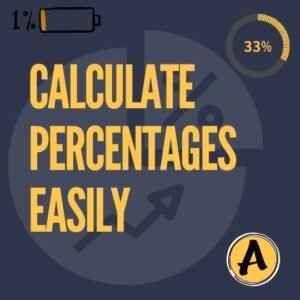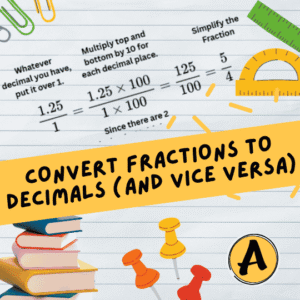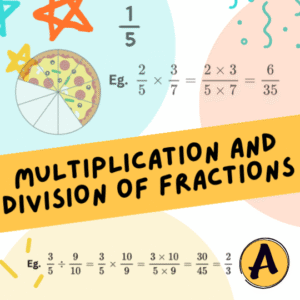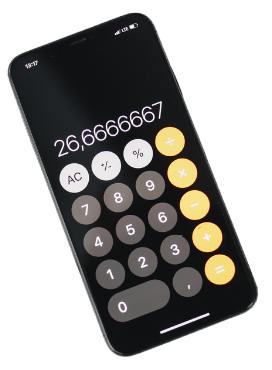Chance and Probability (For Year 5 and Higher)
A chance experiment is any activity with an uncertain outcome — for example, tossing a coin, rolling a die, or drawing a card at random.
Each possible result of the experiment is called an outcome, and the set of all possible outcomes is known as the sample space.
The probability of an outcome is given by:
Probability (P) = (Number of Favourable Outcomes)
(Total Number of Possible Outcomes)
We can write probabilities as percentages, fractions, or decimals. The value is always between 0 and 1, with 0 meaning impossible and 1 meaning certain.
| S. No. | Random Experiment | Sample Space (S) | Number of Sample Points (n(S)) |
| 1 | One coin is tossed | S = {H, T} | n(S) = 2 |
| 2 | Two coins are tossed | S = {HH, HT, TH, TT} | n(S) = 4 |
| 3 | Three coins are tossed | S = {HHH, HHT, HTH, THH, HTT, THT, TTH, TTT} | n(S) = 8 |
| 4 | A die is thrown | S = {1, 2, 3, 4, 5, 6} | n(S) = 6 |
| 5 | Two dice are thrown | S = {(1,1), (1,2), …, (6,6)} | n(S) = 36 |
| 6 | A card is drawn from a pack of playing cards | S = All 52 cards | n(S) = 52 |
Complementary events
Complementary events are two outcomes that cannot happen at the same time — if one happens, the other doesn’t.
In formula form: P(E) + P(not E) = 1
Example: The probability of rolling a 6 on a die is 1/6, and the probability of not rolling a 6 is 5/6.
Practice Questions with Answers and Explanations for Complementary events
Q1. P(rain) = 0.3. Find P(no rain).
A: 0.7
Explanation: 1 − 0.3 = 0.7.
Q2. P(winning) = 0.4. Find P(losing).
A: 0.6
Explanation: Complement = 1 − 0.4.
Q3. A die → P(get even) = 3/6. Find P(not even).
A: 1 − 3/6 = 3/6 = 1/2
Explanation: Odd numbers complement the even numbers.
Q4. P(passing exam) = 0.8. Find P(failing).
A: 0.2
Explanation: 0.8 + 0.2 = 1.
Q5. P(student is left-handed) = 0.15. Find P(right-handed).
A: 0.85
Explanation: 1 − 0.15 = 0.85.
AND Probability (Intersection)
“AND” means both events must happen together.
P(A and B) = P(A) × P(B) → if A and B are independent events.
If A and B are not independent events, then
P(A and B)=P(A)×P(B∣A) → where P(B∣A) means “probability of B given A”.
Example: Tossing two coins, probability of Head AND Head =
P(Head and Head)= (1/2) × (1/2) = 1/4.
Practice Questions with Answers and Explanations for Independent Events
Q1. Two coins → P(both Heads).
A: (1/2)×(1/2)=1/4
Explanation: Independent tosses multiply.
Q2. Roll two dice → P(both show even).
A: (3/6)×(3/6)=1/4
Explanation: Each die independent; evens = 3/6.
Q3. Draw a red card from deck and get a Head on a coin.
A: (26/52)×(1/2)=1/4
Explanation: Card draw and coin toss are independent.
Q4. Two spinners each have 1/4 chance of landing on green. Find P(both green).
A: (1/4)×(1/4)=1/16
Explanation: Events independent.
Q5. P(A)=0.3, P(B)=0.5. Find P(A and B).
A: 0.3×0.5 = 0.15
Explanation: Independent events multiply.
Practice Questions with Answers and Explanations for Not Independent Events
Q1. Bag has 5 red and 3 blue balls. Two drawn without replacement. P(both red).
A: (5/8)×(4/7)=20/56=5/14
Explanation: Second depends on first.
Q2. Class has 10 boys and 5 girls. Two chosen without replacement. P(both girls).
A: (5/15)×(4/14)=20/210=2/21
Explanation: After one girl chosen, only 4 remain.
Q3. Deck of 52 cards. Two drawn without replacement. P(both aces).
A: (4/52)×(3/51)=12/2652=1/221
Explanation: Second draw depends on first.
Q4. Box has 6 red, 4 blue marbles. One red removed. P(next red).
A: (6/10)×(5/9)=30/90=1/3
Explanation: No replacement → dependent.
Q5. 8 students (3 girls, 5 boys). Two chosen without replacement. P(both boys).
A: (5/8)×(4/7)=20/56=5/14
Explanation: The second depends on the first selection.
OR Probability (Union)
“OR” means either one event or the other (or both) can happen.
P(A or B) = P(A) + P(B) – P(A and B).
Special Case: Only if events are mutually exclusive (cannot happen together), then
P(A or B) = P(A) + P(B) → since P(A and B) = 0
Example: Drawing a card, the probability of drawing a King or a Queen.
Total cards = 52
Kings = 4
Queens = 4
These events are mutually exclusive.
P(King or Queen) = P(King) + P(Queen) – P(King and Queen)
= 4/52 + 4/52 – 0; Since P(King and Queen) =0
= 8/52
= 2/13
Therefore, the probability of drawing a King or a Queen is 2/13.
Practice Questions with Answers and Explanations for OR Probability (Union of Events)
Q1. Deck of 52 cards. P(King or Heart).
A: 4/52+13/52−1/52=16/52=4/13
Explanation: Subtract King of Hearts once.
Q2. P(A)=0.4, P(B)=0.3, P(A and B)=0.1. Find P(A or B).
A: 0.4+0.3−0.1=0.6
Explanation: Subtract overlap.
Q3. Roll a die. P(even or multiple of 3).
Evens = {2,4,6}, Multiples of 3 = {3,6}.
A: 3/6+2/6−1/6=4/6=2/3
Explanation: 6 is common to both.
Q4. Two events: P(A)=0.5, P(B)=0.2, P(A and B)=0.1. Find P(A or B).
A: 0.5+0.2−0.1=0.6
Explanation: Apply OR formula.
Q5. From 1–20, P(multiple of 2 or 3).
Multiples of 2=10, of 3=6, of 6=3.
A: (10/20)+(6/20)−(3/20)=13/20
Explanation: Subtract common multiples of 6.
Practice Questions with Answers and Explanations for Mutually Exclusive Events
Q1. Deck of cards → P(King or Queen).
A: 4/52+4/52=8/52=2/13
Explanation: A card can’t be both.
Q2. Roll a die → P(2 or 5).
A: 1/6+1/6=2/6=1/3
Explanation: Can’t roll both 2 and 5 at once.
Q3. Spinner numbered 1–10. P(odd or even).
A: 5/10+5/10=1
Explanation: All numbers covered, no overlap.
Q4. Pick a ball from bag with 3 red, 2 blue. P(red or blue).
A: 3/5+2/5=1
Explanation: Every ball is either red or blue.
Q5. Choose card → P(ace or king).
A: 4/52+4/52=8/52=2/13
Explanation: Mutually exclusive events.









